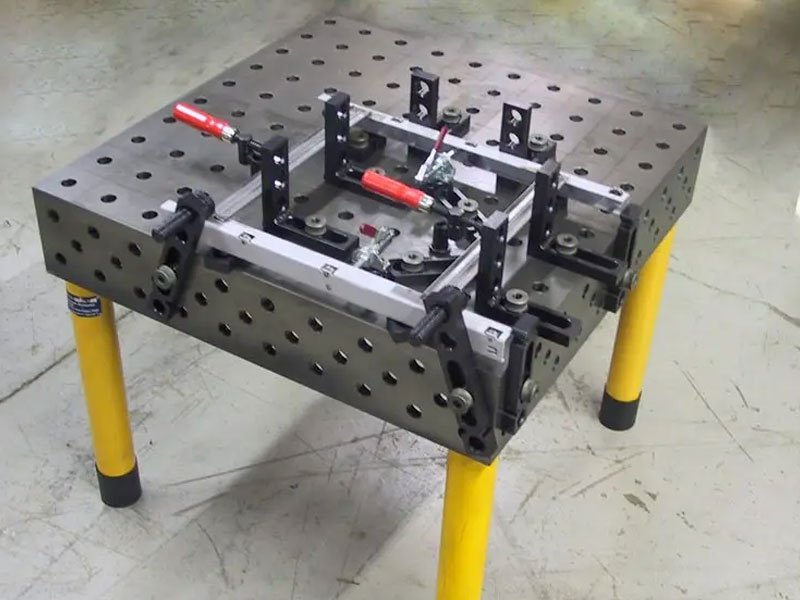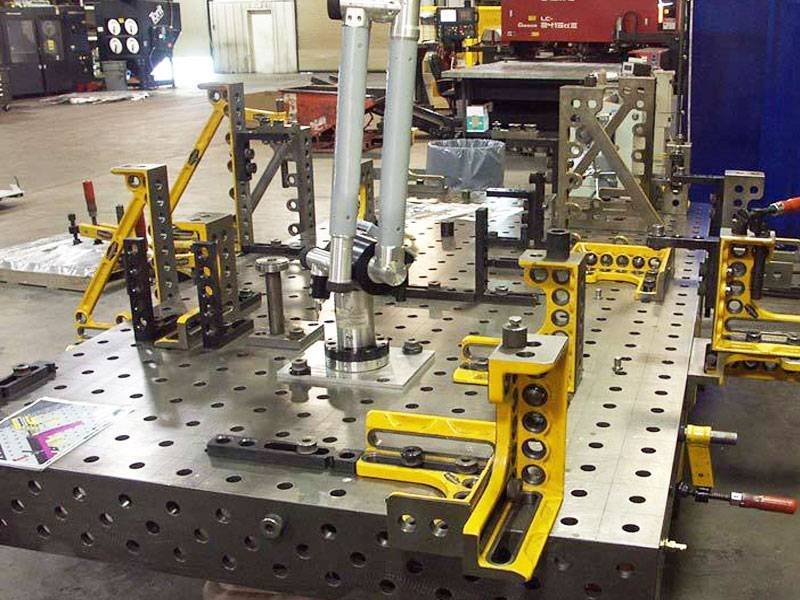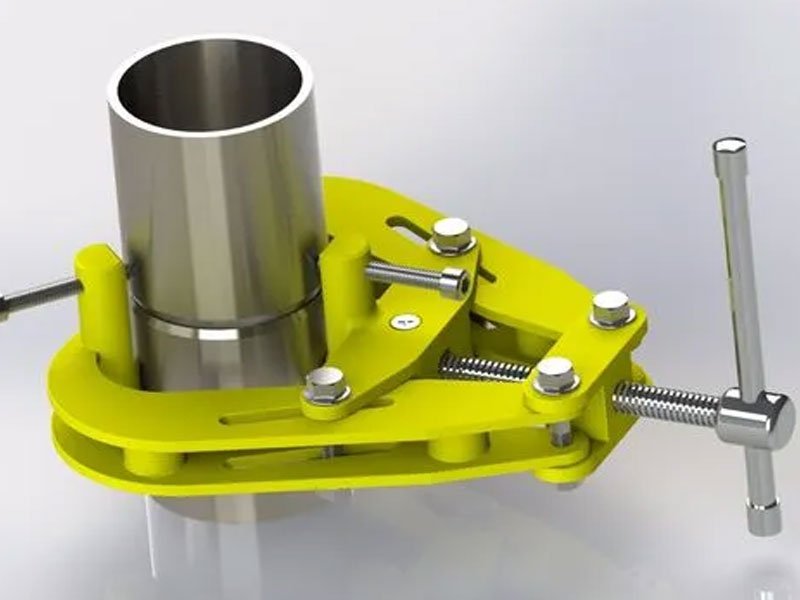Welding is a crucial process in various industries, from construction to manufacturing. It involves fusing two or more pieces of metal together using intense heat. To ensure precise and consistent welds, welding fixtures play an essential role. Welding fixture tables are specifically designed to provide a stable and secure platform for welding operations.

What is Welding Fixture
A welding fixture is a tool or device used to hold and secure the components to be welded in place. It ensures that the parts remain in the correct position and alignment during the welding process, resulting in accurate and consistent welds. Welding fixtures can range from simple clamps to complex, custom-designed systems depending on the complexity and requirements of the welding task.
Features of Welding Fixtures :
- Rigid construction to withstand heat and pressure
- Adjustable components for versatility
- Precision-machined surfaces for accuracy
- Clamping mechanisms to secure workpieces
- Heat-resistant materials to prevent warping
What is the Main Function of Welding Fixtures?
- Stabilization: They provide a stable platform for holding workpieces, preventing movement during welding.
- Positioning: Fixtures ensure precise alignment of components, critical for achieving accurate welds.
- Repeatability: They enable consistent results across multiple welds, improving efficiency and quality in production.
- Safety: By securely holding workpieces, fixtures reduce the risk of accidents and injuries during welding.

Types of Fixture Welding Tables
There are several types of fixture welding tables available, each designed for specific applications and project scales:
- Fixed Welding Tables: These are sturdy, non-adjustable tables with a large working surface, ideal for heavy-duty welding projects.
- Modular Welding Tables: Featuring a grid of holes and slots, these tables allow for flexible positioning of clamps and fixtures.
- Portable Welding Tables: Lightweight and often foldable, these are perfect for on-site welding or small workshops with limited space.
- CNC Welding Tables: Equipped with computer-controlled positioning systems for high-precision automated welding.
- Tilt/Rotate Welding Tables: These tables can be adjusted to various angles, allowing welders to work in optimal positions for different joint types.
How to Choose Welding Fixtures
Workpiece Size and Shape
Select fixtures that can accommodate the size and shape of the workpiece. Ensure they provide adequate support and stability.
Welding Process
Different welding processes (e.g., MIG, TIG, or stick welding) may require specific types of fixtures. Choose fixtures compatible with the welding method used.
Adjustability
For complex or varied welding tasks, opt for adjustable fixtures that allow for flexible positioning and adjustments.
Material
Ensure the fixtures are made from durable materials that can withstand the welding environment, including heat and spatter.

How to Design a Welding Fixture
- Analyze the workpiece: Understand the geometry, material, and welding requirements of the parts to be joined.
- Determine locating points: Identify key reference points on the workpiece for accurate positioning.
- Plan for accessibility: Ensure the fixture allows easy access for welding tools and inspection.
- Consider heat management: Design features that minimize heat distortion and allow for proper cooling.
- Incorporate adjustability: Include elements that allow for fine-tuning and adaptation to different part variations.
- Ensure stability: Design a rigid structure that can withstand welding forces without flexing.
- Optimize for efficiency: Minimize setup time and maximize ease of use for operators.
How to Calculate Clamping Force in Welding Fixture Design
Clamping force is crucial for securing the workpiece during welding. It prevents movement and ensures consistent weld quality. The clamping force can be calculated using the following formula:
Clamping Force = (0.75 x Tensile Strength x Weld Thickness x Weld Length) / Safety Factor
- Determine the Weight of the Workpiece: Calculate the weight of the workpiece that needs to be held.
- Factor in Welding Forces: Consider the forces exerted during welding, including thermal expansion and contraction.
- Calculate Required Clamping Force: Use the formula: Clamping Force = Workpiece Weight × Safety Factor. The safety factor accounts for additional forces and ensures secure holding.
- Select Appropriate Clamps: Choose clamps that can provide the calculated clamping force. Ensure they are adjustable and durable.

Materials Used in Welding Fixture Construction
The choice of materials for welding fixtures is critical to their performance and longevity:
- Steel: Common for its strength and cost-effectiveness, but prone to heat distortion
- Stainless Steel: Offers better heat and corrosion resistance
- Aluminum: Lightweight and good for heat dissipation, but less durable
- Brass: Used for specific components due to its non-stick properties with weld spatter
- Ceramic: Excellent heat resistance for specialized applications
Select materials based on the specific requirements of your welding processes and the expected lifespan of the fixture.
Maintenance and Care of Welding Fixtures
- Regular cleaning to remove weld spatter and debris
- Inspection for wear, damage, or misalignment
- Lubrication of moving parts
- Periodic recalibration to maintain accuracy
- Proper storage to prevent corrosion and damage when not in use
Conclusion
Welding fixture tables are indispensable tools for achieving high-quality, consistent welds in both professional and hobbyist settings. By understanding the types, functions, and design principles of welding fixtures, you can select or create the ideal setup for your specific needs. Remember that the right fixture not only improves weld quality but also enhances safety and efficiency in your welding operations. Whether you’re working on small DIY projects or large-scale industrial fabrications, investing in proper welding fixtures will undoubtedly elevate your welding game and lead to superior results.
FAQ
Are welding fixtures worth it?
Yes, welding fixtures are worth the investment for most welding operations. They improve accuracy, consistency, and efficiency, leading to higher-quality welds and reduced rework. For frequent or precision welding tasks, the benefits often outweigh the initial cost.
Why use brass on welding fixtures?
Brass is used in welding fixtures because it resists weld spatter adhesion. Unlike steel, molten metal droplets don’t stick to brass surfaces, making cleanup easier and prolonging the fixture’s life. Brass components are often used in areas most likely to encounter spatter.
How often should welding fixtures be replaced?
The replacement frequency of welding fixtures depends on usage, maintenance, and the specific application. With proper care, high-quality fixtures can last several years. Regular inspection is crucial; replace fixtures when they show signs of significant wear, damage, or loss of accuracy that affects weld quality.
Can welding fixtures be used for different welding processes?
Many welding fixtures are versatile and can be used across various welding processes, including MIG, TIG, and stick welding. However, some specialized fixtures may be designed for specific processes or materials. Always ensure the fixture is compatible with your welding method and workpiece material.
